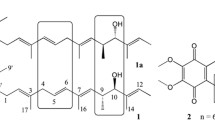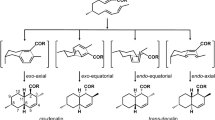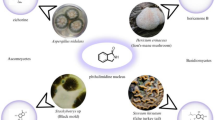Abstract
Pipecolic acid is an important precursor of many useful microbial secondary metabolites. Pipecolic acid-derived moieties are often crucial for the biological activities of some microbial natural products with pharmaceutical applications. Understanding the biogenesis of pipecolic acid in microorganisms would be a significant step toward the mutasynthesis of novel analogs of choice. This review focuses on various microbial pathways and enzymes for pipecolic acid synthesis, especially those related to the origination of pipecolic acid moieties in secondary metabolites.



Similar content being viewed by others
References
Broquist HP (1991) Lysine-pipecolic acid metabolic relationships in microbes and mammals. Annu Rev Nutr 11:435–448
Gupta RN, Spenser ID (1969) Biosynthesis of the piperidine nucleus. The mode of incorporation of lysine into pipecolic acid and into piperidine alkaloids. J Biol Chem 244:88–94
Chang YF, Adams E (1974) d-Lysine catabolic pathway in Pseudomonas putida: interrelations with l-lysine catabolism. J Bacteriol 117:753–764
Chang YF, Adams E (1971) Induction of separate catabolic pathways for l- and d-lysine in Pseudomonas putida. Biochem Biophys Res Commun 45:570–577
Fothergill JC, Guest JR (1977) Catabolism of l-lysine by Pseudomonas aeruginosa. J Gen Microbiol 99:139–155
Miller DL, Rodwell VW (1971) Metabolism of basic amino acids in Pseudomonas putida. Catabolism of lysine by cyclic and acyclic intermediates. J Biol Chem 246:2758–2764
Payton CW, Chang YF (1982) Δ1-piperideine-2-carboxylate reductase of Pseudomonas putida. J Bacteriol 149:864–871
Muramatsu H, Mihara H, Kakutani R, Yasuda M, Ueda M, Kurihara T, Esaki N (2005) The putative malate/lactate dehydrogenase from Pseudomonas putida is an NADPH-dependent Δ1-piperideine-2-carboxylate/delta1-pyrroline-2-carboxylate reductase involved in the catabolism of d-lysine and d-proline. J Biol Chem 280:5329–5335
Yonaha K, Misono H, Yamamoto T, Soda K (1975) d-Amino acid aminotransferase of Bacillus sphaericus: enzymologic and spectrometric properties. J Biol Chem 250:6983–6989
Kusakabe H, Kodama K, Kuninaka A, Yoshino H, Misono H, Soda K (1980) A new antitumor enzyme, l-lysine α-oxidase from Trichoderma viride. Purification and enzymological properties. J Biol Chem 255:976–981
Lukasheva EV, Berezov TT (2002) l-Lysine α-oxidase: physicochemical and biological properties. Biochemistry (Moscow) 67:1152–1158
Bruntner C, Bormann C (1998) The Streptomyces tendae Tu901 l-lysine 2-aminotransferase catalyzes the initial reaction in nikkomycin D biosynthesis. Eur J Biochem 254:347–355
Jordan B, Schmidt RM, Pape H (1984) Nikkomycin formation and lysine metabolism in Streptomyces tendae, In: The 3rd European congress on biotechnology. 1:451–455. Verlag Chemie, Weinheim
Cardenas ME, Zhu D, Heitman J (1995) Molecular mechanisms of immunosuppression by cyclosporine, FK506, and rapamycin. Curr Opin Nephrol Hypertens 4:472–477
Sanglier JJGB, Dreyfuss M, Fehr T, Traber R, Schreier MH (1993) Immunosuppressants of microbial origin, Developments in industrial microbiology series, vol. 32. Wm, C. Brown Publisher, Dubuque, pp 1–27
Paiva NL, Demain AL, Roberts MF (1993) The immediate precursor of the nitrogen-containing ring of rapamycin is free pipecolic acid. Enzyme Microb Technol 15:581–585
Banaszynski LA, Liu, CW, Wandless TJ (2005) Characterization of the FKBP.rapamycin.FRB ternary complex. J Am Chem Soc 127:4715–4721
Choi J, Chen J, Schreiber SL, Clardy J (1996) Structure of the FKBP12-rapamycin complex interacting with the binding domain of human FRAP. Science 273:239–242
Meadows RP, Nettesheim DG, Xu RX, Olejniczak ET, Petros AM, Holzman TF, Severin J, Gubbins E, Smith H, Fesik SW (1993) Three-dimensional structure of the FK506 binding protein/ascomycin complex in solution by heteronuclear three- and four-dimensional NMR. Biochemistry 32:754–765
Byrne KM, Shafiee A, Nielsen J, Arison B, Monaghan RL, Kaplan L (1993) The biosynthesis and enzymology of an immunosuppressant, immunomycin, produced by Streptomyces hygroscopicus var. ascomyceticus. Dev Ind Microbiol 32:29–45
Molnar I, Aparicio JF, Haydock SF, Khaw LE, Schwecke T, Konisg A, Staunton J, Leadlay PF (1996) Organization of the biosynthetic gene cluster for rapamycin in Streptomyces hygroscopicus: analysis of genes flanking the polyketide synthase. Gene 169:1–7
Schwecke T, Aparicio JF, Molnar I, Konig A, Khaw LE, Haydock SF, Oliynyk M, Caffrey P, Cortes J, Lester JB et al (1995) The biosynthetic gene cluster for the polyketide immunosuppressant rapamycin. Proc Natl Acad Sci USA 92:7839–7843
Sans N, Schindler U, Schroder J (1988) Ornithine cyclodeaminase from Ti plasmid C58: DNA sequence, enzyme properties and regulation of activity by arginine. Eur J Biochem 173:123–130
Schindler U, Sans N, Schroder J (1989) Ornithine cyclodeaminase from octopine Ti plasmid Ach5: identification, DNA sequence, enzyme properties, and comparison with gene and enzyme from nopaline Ti plasmid C58. J Bacteriol 171:847–854
Khaw LE, Bohm GA, Metcalfe S, Staunton J, Leadlay PF (1998) Mutational biosynthesis of novel rapamycins by a strain of Streptomyces hygroscopicus NRRL 5491 disrupted in rapL, encoding a putative lysine cyclodeaminase. J Bacteriol 180:809–814
Motamedi H, Shafiee A (1998) The biosynthetic gene cluster for the macrolactone ring of the immunosuppressant FK506. Eur J Biochem 256:528–534
Wu K, Chung L, Revill WP, Katz L, Reeves CD (2000) The FK520 gene cluster of Streptomyces hygroscopicus var. ascomyceticus (ATCC 14891) contains genes for biosynthesis of unusual polyketide extender units. Gene 251:81–90
Muth WL, Costilow RN (1974) Ornithine cyclase (deaminating). III. Mechanism of the conversion of ornithine to proline. J Biol Chem 249:7463–7467
Namwat W, Kamioka Y, Kinoshita H, Yamada Y, Nihira T (2002) Characterization of virginiamycin S biosynthetic genes from Streptomyces virginiae. Gene 286:283–290
Paris JM, Barriere JC, Smith C, Bost PE (1990) The chemistry of pristinamycins. Recent progress in the chemical synthesis of antibiotics. Springer, Berlin Heidelberg New York, pp 183–248
Yamada Y, Nihira T, Sakuda S (1997) Butyrolactone autoregulators, inducers of virginiamycin in Streptomyces virginiae: their structures, biosynthesis, recepter proteins, and induction of virginiamycin biosynthesis. In: Strolhl WR (ed) Biotechnology of antibiotics. Marcel Dekker, New York, pp 63–79
Molinero AA, Kingston DGI, Reed JW (1989) Biosynthesis of antibiotics of the virginiamycin family. 6. Biosynthesis of virginiamycin S1. J Nat Prod 52:99–108
Reed JW, Purvis MB, Kingston DGI, Biot A, Gossele F (1989) Biosynthesis of antibiotics of the virginiamycin family. 7. Stereo-and regiochemical studies on the formation of the 3-hydroxypicolinic acid and pipecolic acid units. J Org Chem 54:1161–1165
Namwat W, Kinoshita H, Nihira T (2002) Identification by heterologous expression and gene disruption of VisA as l-lysine 2-aminotransferase essential for virginiamycin S biosynthesis in Streptomyces virginiae. J Bacteriol 184:4811–4818
Broquist HP (1985) The indolizidine alkaoids, slaframine and swainsonine: contaminants in animal forages. Annu Rev Nutr 5:391–409
Wickwire BM, Harris CM, Harris TM, Broquist HP (1990) Pipecolic acid biosynthesis in Rhizoctonia leguminicola. I. The lysine saccharopine, Δ1-piperideine-6-carboxylic acid pathway. J Biol Chem 265:14742–14747
Wickwire BM, Wagner C, Broquist HP (1990) Pipecolic acid biosynthesis in Rhizoctonia leguminicola. II. Saccharopine oxidase: a unique flavin enzyme involved in pipecolic acid biosynthesis. J Biol Chem 265:14748–14753
Kinzel JJ, Bhattacharjee JK (1979) Role of pipecolic acid in the biosynthesis of lysine in Rhodotorula glutinis. J Bacteriol 138:410–417
Kurtz M, Bhattacharjee JK (1975) Biosynthesis of lysine in Rhodotorula glutinis: role of pipecolic acid. J Gen Microbiol 86:103–110
Rius N, Demain AL (1997) Lysine ε-aminotransferase, the initial enzyme of cephalosporin biosynthesis in actinomycetes. J Microbiol Biotechnol 7:95–100
Aharonowitz Y, Cohen G, Martin JF (1992) Penicillin and cephalosporin biosynthetic genes: structure, organization, regulation, and evolution. Annu Rev Microbiol 46:461–495
Tobin MB, Kovacevic S, Madduri K, Hoskins JA, Skatrud PL, Vining LC, Stuttard C, Miller JR (1991) Localization of the lysine ε-aminotransferase (lat) and Δ-(L-α-aminoadipyl)-l-cysteinyl-d-valine synthetase (pcbAB) genes from Streptomyces clavuligerus and production of lysine ε-aminotransferase activity in Escherichia coli. J Bacteriol 173:6223–6229
Madduri K, Stuttard C, Vining LC (1989) Lysine catabolism in Streptomyces spp. is primarily through cadaverine: β-lactam producers also make α-aminoadipate. J Bacteriol 171:299–302
Fujii T, Narita T, Agematu H, Agata N, Isshiki K (2000) Characterization of l-lysine 6-aminotransferase and its structural gene from Flavobacterium lutescens IFO3084. J Biochem 128:391–397
Soda K, Misono H, Yamamoto T (1968) l-Lysine:α-ketoglutarate aminotransferase. I. Identification of a product, Δ1-piperideine-6-carboxylic acid. Biochemistry 7:4102–4109
Fujii T, Mukaihara M, Agematu H, Tsunekawa H (2002) Biotransformation of l-lysine to l-pipecolic acid catalyzed by l-lysine 6-aminotransferase and pyrroline-5-carboxylate reductase. Biosci Biotechnol Biochem 66:622–627
Fujii T, Aritoku Y, Agematu H, Tsunekawa H (2002) Increase in the rate of l-pipecolic acid production using lat-expressing Escherichia coli by lysP and yeiE amplification. Biosci Biotechnol Biochem 66:1981–1984
Brandriss MC, Falvey DA (1992) Proline biosynthesis in Saccharomyces cerevisiae: analysis of the PRO3 gene, which encodes Δ1-pyrroline-5-carboxylate reductase. J Bacteriol 174:3782–3788
Delauney AJ, Verma DP (1990) A soybean gene encoding Δ1-pyrroline-5-carboxylate reductase was isolated by functional complementation in Escherichia coli and is found to be osmoregulated. Mol Gen Genet 221:299–305
Leisinger T (1987) Biosynthesis of proline. In: Neidhardt FC, Ingraham JL, Low KB, Magasanic B, Schaechter M, Umbarger HE (eds) Escherichia coli and Salmonella typhimurium: cellular and molecular biology. American Society for Microbiology, Washington, pp 345–351
Smith RJ, Downing SJ, Phang JM, Lodato RF, Aoki TT (1980) Pyrroline-5-carboxylate reductase activity in mammalian cells. Proc Natl Acad Sci USA 77:5221–5225
Aspen AJ, Meister A (1962) Conversion of α-aminoadipic acid to l-pipecolic acid by Aspergillus nidulans. Biochemistry 1:606–612
Casqueiro J, Bañuelos O, Sutiérrez S, Martín JF (2001) Metabolic engineering of the lysine pathway for β-lactam overproduction in Penicillium chrysogenum. In: Van Broedkhoven A, Anne J, Shapiro F (eds) Focus on biotechnology, vol.1. Novel frontiers in the production of compounds for biomedical use. Kluwer Academic Publishers, Dordrecht, pp 147–159
Naranjo L, Martin de Valmaseda E, Banuelos O, Lopez P, Riano J, Casqueiro J, Martin JF (2001) Conversion of pipecolic acid into lysine in Penicillium chrysogenum requires pipecolate oxidase and saccharopine reductase: characterization of the lys7 gene encoding saccharopine reductase. J Bacteriol 183:7165–7172
Naranjo L, Martin de Valmaseda E, Casqueiro J, Ullan RV, Lamas-Maceiras M, Banuelos O, Martin JF (2004) Inactivation of the lys7 gene, encoding saccharopine reductase in Penicillium chrysogenum, leads to accumulation of the secondary metabolite precursors piperideine-6-carboxylic acid and pipecolic acid from α-aminoadipic acid. Appl Environ Microbiol 70:1031–1039
Kuo MS, Yurek DA, Mizsak SA, Cialdella JI, Baczynskyj L, Marshall VP (1999) Biosynthesis of the pipecolate moiety of marcfortine A. J Am Chem Soc 121:1763–1767
Acknowledgements
The author thanks Drs. Hao Jiang, John Hucul, Edmund Graziani, Frank Koehn, and Mr. Bradley Haltli for valuable discussions and comments.
Author information
Authors and Affiliations
Corresponding author
Rights and permissions
About this article
Cite this article
He, M. Pipecolic acid in microbes: biosynthetic routes and enzymes. J IND MICROBIOL BIOTECHNOL 33, 401–407 (2006). https://doi.org/10.1007/s10295-006-0078-3
Received:
Accepted:
Published:
Issue Date:
DOI: https://doi.org/10.1007/s10295-006-0078-3




